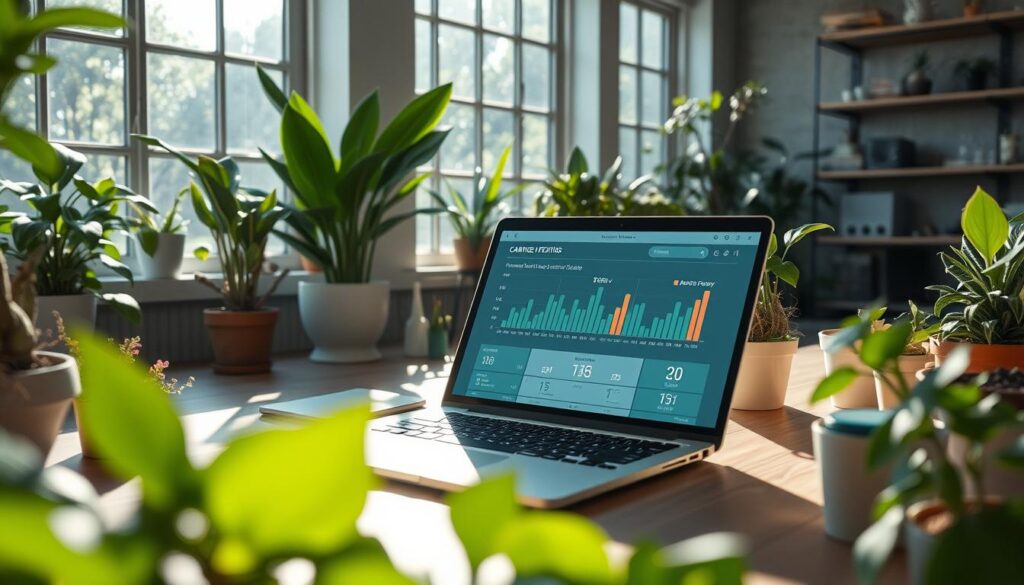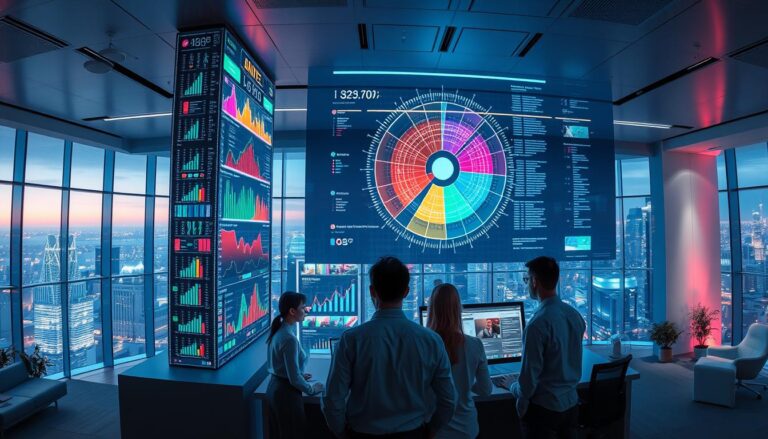In our time, digital tech has two sides. It drives innovation but also adds to our planet’s issues. The role of software development for the environmental sector is now essential. This is because software is key in businesses. And using environmental software solutions that focus on eco-efficiency is both a smart and necessary move.
Digital tech has a big impact: it’s responsible for 4% of the world’s greenhouse gas emissions. This is even more than what flying contributes. Companies like Savvycom are stepping up. They’re adopting eco-friendly software development methods. The EU’s Green Deal aims for no net emissions by 2050. Thus, companies, including Google, are working towards being carbon neutral.
Data centers use about 1% of the world’s electricity. This might grow. But, optimizing cloud resources can reduce this usage by 40%. This shift towards green software development is key. It lessens environmental harm, saves costs, and conserves resources.
This push for a greener future means software now does more. It helps improve environmental quality, supports sustainable planning, and keeps up with new standards.
Key Takeaways
- Emerging green software development strategies focus heavily on energy efficiency and sustainability.
- Software solutions are increasingly geared towards aiding the monitoring and analysis of environmental parameters and compliance.
- Advancements in technology such as virtualization contribute significantly to power usage reduction in data centers.
- eco-friendly software development initiatives directly support long-term environmental and corporate sustainability goals.
- Choosing the right software development partner with a focus on eco-friendly practices is critical for businesses prioritizing sustainability.
- Sustainable software practices offer a pathway not only towards environmental responsibility but also towards operational cost savings.
Understanding the Environmental Sector’s Unique Needs
The growth of the environmental sector is fast. It needs specialized software. This software has to meet rules and be green. It helps make decisions for a sustainable future.

Key Challenges Faced by Environmental Organizations
Environmental groups face many challenges. These include following strict rules and needing up-to-date data. The tech sector also adds to global emissions, which is a concern.
Importance of Tailored Software Solutions
For these groups, special green technology software is essential. It helps with detailed reports and monitoring energy use. This makes it easier to make choices based on data.
Trends Shaping the Environmental Technology Landscape
- Using AI for accurate environmental impact assessments
- Using IoT to make operations more resource-efficient
- Moving to digital certificates for green businesses to increase trust and transparency
These trends show how important software developers are. They help businesses become more sustainable. They also help meet global environmental goals, like those from the United Nations Environment Programme (UNEP).
| Environmental Trend | Technology Used | Impact on Sustainability |
|---|---|---|
| Digital Green Certifications | Blockchain & Smart Contracts | Enhances transparency and trust in environmental reporting |
| Real-time ESG Reporting | Big Data Analytics | Enables dynamic decision-making and improved compliance |
| Resource Optimization | IoT Devices | Reduces waste and lowers operational costs |
Green technology software is becoming crucial for the environmental sector. It changes how organizations approach being green. They can be environmentally friendly while still doing well in business.
The Role of Software Development in Sustainability
There’s a growing worry about how our actions affect the environment. This has made the IT world work harder to be green. The push for climate-conscious software development combines tech advances with caring for the planet. The IT sector’s effect on the climate is as big as the aviation industry’s. So, developers and companies are now creating software for environmental conservation.
Enhancing Resource Management
Key to being sustainable is using resources wisely. This is vital to cut waste and work more efficiently. Software that helps with managing resources lets companies track how much they use. For example, by using advanced analytics, they can see exactly how water and energy are used. This doesn’t just save money. It also helps meet sustainability goals in the long run.
Optimizing Waste Management Processes
Software is changing how we handle waste, making it easier and less prone to mistakes. It improves when waste is collected and helps sort and recycle better. With climate-conscious software development, businesses can greatly lessen their harm to the environment. This helps them meet their bigger goals for staying green.
Facilitating Regulatory Compliance
Staying on top of environmental laws is crucial. It’s tricky because of the many regulations. But, strong software systems help businesses stay in line and avoid legal problems. These systems do more than just keep track of emissions. They automate reporting and handling data on environmental impacts. This supports efforts for software for environmental conservation.

To wrap it up, as we learn more about environmental harm, software’s role in fighting it grows. Turning to smart, sustainable solutions lets businesses aim higher. They’re redefining tech success by how well it protects our earth’s resources.
Innovations in Eco-Focused Software Development
Industries are moving towards sustainability, and software development is joining this trend. There are new tools that help both the environment and businesses. By choosing sustainable tech solutions, the goal is to lessen environmental harm using advanced software.
One key innovation is using cloud computing to cut down the carbon footprint. By going cloud-based, companies use less energy than traditional data centers need. They’re switching to services powered by renewable energy. This step forward supports eco-efforts and offers growth and flexibility.
Cloud Computing for Environmental Applications
Cloud computing makes tech more sustainable. It betters server use and cuts down extra gear. Google, for example, has cut its energy use by 40% using AI for better cooling in data centers.
Data Analytics for Environmental Impact Assessment
Advanced data analytics plays a big role in eco-software. It helps understand and track resource use. This helps predict and prevent bad impacts on the environment.
AI and Machine Learning in Sustainability Efforts
AI and machine learning also help make tech greener. They help crunch big data for smarter resource use, boosting energy use and making renewable energy sources more steady and effective.
The fight against climate change is helped by smart software. Using less energy in apps and going serverless are just two ways the tech world is helping. Companies that invest in these areas meet, and often beat, standards and stand out as sustainable leaders. Learn more about it here.
By bringing eco-innovations to software development, we’re not just solving current issues. We’re also supporting long-term global goals for sustainability and changing industry standards for the better.
Case Studies: Successful Implementations
Software development in the environmental sector is changing how organizations work and help the planet. Using environmental conservation software is boosting corporate responsibility and economic gains.
Nonprofit Organizations Leveraging Technology
Nonprofit groups are using environmental software to grow their conservation work. They use digital tools to gather and analyze data. This helps them track wildlife and deforestation better.
Corporate Sustainability Initiatives Powered by Software
Big companies are using environmental software to meet their green goals. For example, firms with emissions tracking have cut their carbon footprint by up to 30%. This move aids global sustainability and increases production efficiency by 15%.
Government Solutions for Environmental Monitoring
Government agencies use software for environmental monitoring. It helps manage IoT technology and smart fleets. This improves environmental governance and compliance worldwide.
| Statistic | Impact |
|---|---|
| Companies using climate management software | Reduce greenhouse gas emissions by up to 15% in one year |
| Global electricity generation from renewables | Projected to rise from 29% (2021) to 50% by 2030 |
| Manufacturers integrating sustainable practices | 30% decrease in carbon footprint |
| Sustainability in agriculture through technology | Up to 20% more food production while halving emissions |
| Global retailer with advanced inventory system | 22% reduction in operational costs within first year |
Choosing the Right Software Development Partner
Finding eco-friendly software partners is crucial for those focused on the environment. These partners need to understand both technology and its environmental impact well. It’s about finding people skilled in making tech work for sustainability.
Criteria for Evaluating Eco-Tech Development Firms
Choosing a software partner involves looking at many things. You need someone technically savvy who gets the unique needs of the environmental field. A firm’s past successes, like creating low-energy programs, show they can do the job. Companies such as Innowise, Datarockets, and BairesDev are leading the charge. They’re known for custom solutions and clear, adaptive communication.
Importance of Industry Experience and Expertise
Passion for green causes is good, but not enough. The experience and know-how in this field are also key. Look for firms with proven success in environmental work, like Brainhub and Digiteum. They bring deep knowledge to your projects. It’s about more than just finishing a job. It’s finding a partner who shares your vision, tackles green challenges well, and brings fresh tech solutions.
Collaborating for Long-Term Environmental Goals
True success in software partnerships means sharing long-term green goals. Your partner should be as dedicated to saving the planet as you are. This kind of teamwork blends beliefs and goals, especially important as IT outsourcing grows. With the right firm, companies can increase their profits and streamline operations without sacrificing their green commitments.



